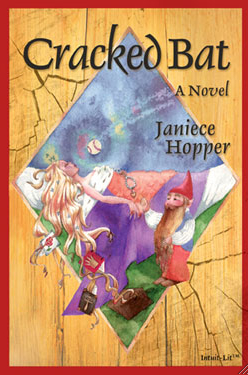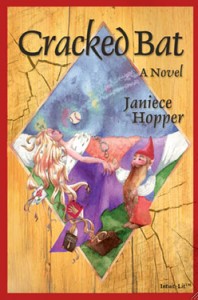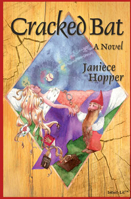In light of recent events, I’m taking a break from my ongoing series on what standard format for book manuscripts looks like — don’t worry; it will return next week, along with some tips on writing and formatting a query letter — and taking the weekend off. (I know: practically unheard-of here at Author! Author!) In order to give you some fresh material for weekend pondering, I threw myself on the mercy of FAAB (Friend of Author! Author! blog), blogger, and novelist Janiece Hopper. She very kindly agreed to help us out. Thank you, Janiece!
For those of you who missed my wholesale gloating when Janiece’s first novel, Cracked Bat, came out — I love announcing my readers’ triumphs! — here’s a brief synopsis:
Linnea Perrault is the editor of The Edge, a successful community newspaper. Happily married to Dan, Spinning Wheel Bay’s premier coffee roaster and owner of The Mill, she is the mother of an adorable four-year-old daughter who insists upon lugging a fifteen-pound garden dwarf everywhere they go.When Linnea’s wealthy father returns to their hometown to make amends for abandoning her to a cruel stepfather twenty-eight years earlier, she painfully resurrects his old place in her heart. He buys the local baseball team. Before long, fairy tales, Islamic mystics, and a host of cross-cultural avatars come into play as the team is propelled to the top of the league. After a foul pass and an accident at the stadium, Linnea finds herself locked in the stone tower of pain as she realizes how much the man she married is like the father she never knew. Doctors can’t diagnose her debilitating condition, but kind, magical strangers give her a chance to save her soul. Cracked Bat is dedicated to the approximately five million people who have experienced the mystifying and frustrating ailments of myofascial pain syndrome, fibromyalgia, and chronic fatigue.
As you may see, it’s not a novel that is particularly easy to assign to a book category — which is one of the many reasons that I’m particularly thrilled that Janiece has given in to my blandishment to share her self-publishing experiences with us. I know that many of you write between genres and thus must have given dead-of-night thought to a question haunting many fiction writers these days: what would happen if I published it myself?
It’s a great question — and here is an author who can answer it from direct personal experience. Take it away, Janiece!
Hello everyone! I am absolutely delighted to be Anne’s guest blogger. So thank you, Anne. Today, I am going to share why I created Ten Pentacles to publish my novel, Cracked Bat. Self-publishing works for me because it reflects my relationship with writing and my purpose for doing the work.
We’ve all heard agents at conferences say that good writing will always find a home. This storyline serves. It keeps aspiring authors going to conferences and certainly helps keep the United States Postal Service in business. (Just think how much you’ve spent on stamps for query letters and how much you’ve paid in return postage for bulky, boxed manuscripts.) Unfortunately, the idea that good writing will always find a publisher to finance and promote it is simply not true.
In reality, the current publishing paradigm requires authors to tweak and twist their “good” writing until an agent can see (in a split-second, mind you) exactly how it fits into a publisher’s pre-established list and how it appeals to a pre-determined market.
I’m not critiquing, but after two years of intense writing, repetitive stress injury, and a divorce, I wasn’t willing to force Cracked Bat to be anything other that what it became. Whether or not a New York agent could “fall in love” with Linnea Perrault on the first page so that she could bulldoze a bleary-eyed, overworked editor into buying it with her enthusiasm became completely irrelevant.
Cracked Bat is good, true, beautiful, quirky…and exactly what I hoped it would be. But it is different. I call it Intuit-Lit.
Intuit-Lit illuminates limiting socially-constructed and neurologically-wired thought, behavorial, and physiological patterns so that characters can recast and overcome obstacles on their life paths. By sharing the characters’ experiences, I hope my find themselves further along on their own life journeys and are more conscious of and more comfortable with their own intuitive abilities. Please see my blog for more about how the blank stare of agents actually guided me to this rewarding work.
Cracked Bat faces what is painful truth for many Gen X women and transforms what must die into new life. The painful truth in the publishing industry today is, fiction that doesn’t “fit in” with what’s out there either dies in a drawer or needs a dynamic new structure to support it.
In Cracked Bat, Linnea Perrault learns to speak her truth in an unreceptive environment. As she embraces her authenticity, she takes responsibility for the outcome of her choices and her actions. In developing her character, I strengthened that part of myself. I didn’t want Cracked Bat to stagnate on a flash drive in my safety deposit box, so I took on the responsibility of creating something new, Ten Pentacles, to bring the book into being.
Authors pitching a book often find themselves in an unreceptive environment and spend a lot of time and energy trying to figure out how to make their creative “babies” conform to a distant other’s vision. It is very dysfunctional to parent the children we birth this way and it’s a disservice to our muse to force the art our “selves” create into a marketer’s take on reality.
Just as writing Cracked Bat led me to choose a more authentic life, I want this novel to live a book’s life that is consistent with its unique energy. I’m still figuring out exactly what that means, but I love being on this path. I love that it was my choice to print on recycled paper and not to ship it out in reams of bubble-wrap. I don’t care that my cover isn’t compatible with what’s on the shelves of the local bookstore today. The fact that my cover is deeply integrated with the story is more important to me than competing with someone else’s image.
Writers with traditional publishers almost never have any say over their book covers at all. I think this is almost abusive. We ought to get to dress our “baby,” the way we want to. I always wanted my cover to have a sleeping beauty on a massage table in the middle of a baseball diamond and I loved brainstorming all the symbolic images that could be embedded in that picture. I knew I wanted the cover to look like a cracked wooden bat and to have lots of red and white on it, like a baseball. I also wanted red, white, and black because I associate these colors with the Triple Goddess. Imagine explaining the need to honor that to someone at a traditional publishing house!
Well, the Universe stepped in to help me get just the look I wanted. Just as I began to consider forming Ten Pentacles, an educational assistant was assigned to my English as a Second Language classroom. She didn’t stay long before being moved to a higher needs assignment, but she was with me long enough to mention that she was a watercolor artist. I asked to see her work and loved it. The rest is history:
Now, at first glance, some people think Cracked Bat is a children’s book. As a former school librarian I can understand the misperception. Was that horrible packaging on my part?
No, I don’t think so. Not for this novel because this book is for people who are willing to take time to look beyond the surface, who go deep, and who can remember the thrill of settling down to let the magic of a fairy tale seep into their psyche.
Of course, I want to sell a million copies of my book, but only so that I could have more time to creative what I want to create. Choosing to self-publish, self-promote, and self-distribute while single-parenting teenagers and teaching full-time does seem to diminish my chances of hitting the bestseller mark.
Yet truly “owning” my story, both literally and figuratively, is far more satisfying than I ever imagined. I love my book so much that I’m actually I’m happy to have boxes full of yet-to-be sold, sealed with joy, and delivered (yes, via USPS) copies stacked all around my writing space. I love its physical manifestation so much that I’m grateful to the bank and glad to write the checks toward paying off the hefty loan I had to take out to get it printed. I can image my dad snickering at my business sense. Go ahead. I can laugh at it, too. I’m lucky enough to have a day job that I love as much as writing.
People always ask me if this was expensive. They ask how I started a company, designed a website, edited, proofed, published, and marketed while going through a major life transition. I know Anne’s readers expect honesty, so here it goes. Financially speaking, I have excellent credit…and I have become quite talented at justifying expenses that help me grow. For about the price of flying to and participating in Maui’s Writer’s Retreat and Conference (which I’ve always wanted to do) and hanging out on the beach for a few extra days (which any new divorcee seems entitled to), I created a company and produced my books. I missed out on the leis, the sand, and the great company, but I’ve got a very significant book in print.
Energetically, I have no idea how I did everything I did to make it happen. At one point, I realized I would never feel fulfilled, no matter how many beautiful seashores I visited or how many more writing classes I took until Cracked Bat was available for people who might want or actually need to read it. All I can say is that I was propelled by the story itself to get it out there. (I also have empathetic, creative sons who cheerfully make their own dinner several nights a week and do their own laundry.)
I truly wish all of Anne’s readers the best of luck in pursuing publication and hope you sell tons of books. But, above all, I urge you to honor your good writing in your heart and then, it will always have the home it really wants.
 Janiece Hopper lives in Snohomish, Washington. She met her first garden dwarf on an island in the Pacific Northwest when she was four years old. Thirty years later she met a witch in the same place. As an elementary school teacher, librarian, and book reviewer with an M.Ed. from the University of Washington and a B.A. from California State University, she always struggled with calling fairy tales fiction. Intuit-Lit has resolved her conflict nicely. If Janiece ever goes to another baseball game, she’ll be the woman in the stands, trying to drink a mocha while wearing full catcher’s gear.
Janiece Hopper lives in Snohomish, Washington. She met her first garden dwarf on an island in the Pacific Northwest when she was four years old. Thirty years later she met a witch in the same place. As an elementary school teacher, librarian, and book reviewer with an M.Ed. from the University of Washington and a B.A. from California State University, she always struggled with calling fairy tales fiction. Intuit-Lit has resolved her conflict nicely. If Janiece ever goes to another baseball game, she’ll be the woman in the stands, trying to drink a mocha while wearing full catcher’s gear.



